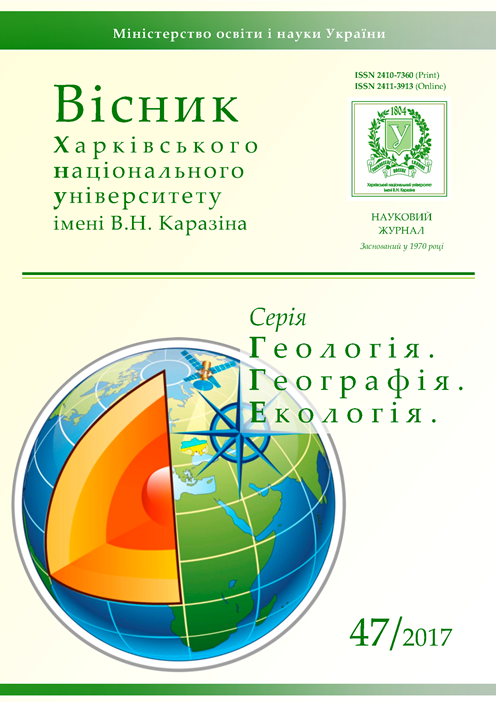Демографічна деградація Сєвєродонецько-Лисичанської агломерації в пострадянський період
Анотація
В статті проведений аналіз динаміки чисельності населення і темпів його приросту для Сєвєродонецько-Лисичанської агломерації та окремих її населених пунктів у пострадянський період. Визначено, що для досліджуваної агломерації характерні депопуляція та субурбанізаційні процеси. Оцінено втрати населення Сєвєродонецько-Лисичанської агломерації протягом останніх десятиліть за різними підходами, зокрема доведено, що вони практично для всіх її міських поселень є дуже значними (перевищують 5 % за десятиліття), а сама агломерація за показником скорочення населення (більше 10 % за тридцятирічний період) є депресивною. Виявлено сучасні демографічні проблеми агломерації в умовах її розташування, з одного боку, в старопромисловому регіоні, а з іншого – в зоні проведення антитерористичної операції. Враховуючи інші проблеми розвитку (соціальні, економічні, геополітичні, екологічні тощо), доведено, що агломерація на сучасному етапі розвитку є кризовою. Визначено, що геополітична криза на сході України має як негативний, так і позитивний вплив на розвиток агломерації в цілому та на динаміку чисельності її населення зокрема.
Завантаження
Посилання
2. Баканов С. А. Демографическая деградация городов в старопромышленных районах Урала (1959–2010) [Електронний ресурс] / C. А. Баканов. – Режим доступу : http://elar.urfu.ru/bitstream/10995/47077/1/ qr_1_2017_05.pdf
3. Всесоюзная перепись населения 1989 г. Численность населения союзных республик СССР и их территориа-льных единиц по полу [Електронний ресурс]. – Режим доступу : http://demoscope.ru/weekly/ssp/ sng89_reg1.php
4. Гусєва Н. В. Проблеми розвитку Сєвєродонецько-Лисичанської агломерації в нових геоплітичних реаліях / Н. В. Гусєва, О. М. Задєсєнцев // Науковий вісник Херсонського державного університету : зб. наук. праць. Серія : Географічні науки. – Херсон, 2017. – № 7. – С. 36-42.
5. Гусєва Н. В. Типологічні ознаки Сєвєродонецько-Лисичанської агломерації / Н. В. Гусєва, О. М. Задєсєнцев // Економічна та соціальна географія : наук. зб. – К., 2017. – Вип. 77. – С. 10‒18.
6. Гусєва Н. В. Сєвєродонецько-Лисичанська агломерація: межі, склад, структура / Н. В. Гусєва, О. М. Задєсєнцев // Регіон‒2016: стратегія оптимального розвитку : матеріали міжнар. наук.-практ. конф. (м. Харків, 10‒11 листопада 2016 р.). – Харків : ХНУ імені В. Н. Каразіна, 2016. – С. 270‒275.
7. Мельник І. Г. Динамічні аспекти розвитку великих міст України / І. Г. Мельник // Регіон‒2017: стратегія оптимального розвитку : Матеріали міжнар. наук.-практ. конф. (м. Харків, 19‒20 вересня 2017 р.). – Хар-ків : ХНУ імені В. Н. Каразіна, 2017. – С. 106‒108.
8. Мельник І. Міські поселення Луганщини: нові виклики на фоні старих проблем / І. Мельник // Урбаністична Україна: в епіцентрі просторових змін : колективна монографія / За ред. К. Мезенцева, О. Олійника, Н. Мезенцевої. – К. : Видавництво «Фенікс», 2017. – С. 121‒142.
9. Міграція з окупованих територій: куди прямують переселенці [Електронний ресурс] // Слово і діло. Голов-ний сайт про політиків. – Режим доступу : https://www.slovoidilo.ua/2017/02/13/infografika/suspilstvo/
mihracziya-z-okupovanyx-terytorij-kudy-pryamuyut-pereselenczi
10. Про кількість та склад населення України за підсумками Всеукраїнського перепису населення 2001 року [Електронний ресурс]. – Режим доступу : http://2001.ukrcensus.gov.ua/results/general/city/
11. Проскурніна А. А. Статистичний аналіз чисельності та структури населення країни [Електронний ресурс] / А. А. Проскурніна // Управління розвитком. – 2014. – № 11. – С. 153-156. – Режим доступу : http://
nbuv.gov.ua/UJRN/Uproz_2014_11_56
12. Статистичний щорічник Луганської області за 2009 рік / За ред. С. Г. Пілієва; Головне управління статис-тики у Луганській області. – Луганськ, 2010. – 514 с.
13. Статистичний щорічник Луганської області за 2013 рік / За ред. І. В. Шаблієнко; Головне управління ста-тистики у Луганській області. – Луганськ, 2014. – 479 с.
14. Статистичний щорічник Луганської області за 2015 рік / За ред. Д. Я. Протопопова; Головне управління статистики у Луганській області. – Сєвєродонецьк, 2016. – 428 с.
15. Чисельність наявного населення України на 1 січня 2016 року [Електронний ресурс] / Відп. за випуск М. Б. Тімоніна. – К. : Державна служба статистики України. – 86 c. – Режим доступу : http:// www.ukrstat.gov.ua/
16. Rowland R. H. Declining and Stagnant Towns of the USSR / R. H. Rowland // Soviet Geography : Rev. and Translation. – 1980. – № 21. – P. 195–218.





